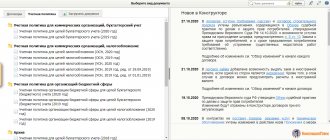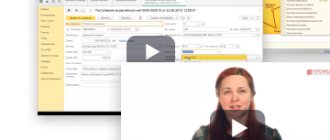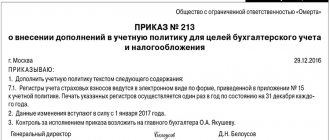We develop and record a working chart of accounts
The working chart of accounts is an integral part of the accounting policy of any organization. Usually it is given in one of the appendices to the order approving the accounting policy . The need for its development is determined, first of all, by legal requirements. After all, in accordance with Art. 6 of the Federal Law of November 21, 1996 N 129-FZ “On Accounting”, each organization, when approving its accounting policy, must approve, among other things, a working chart of accounts containing synthetic and analytical accounts necessary for maintaining accounting records in accordance with timeliness requirements and completeness of accounting and reporting. A similar requirement is enshrined in clause 4 of PBU 1/2008 “Accounting Policy of the Organization” (approved by Order of the Ministry of Finance of Russia dated October 6, 2008 N 106n). State, budgetary and autonomous institutions should also formulate a working chart of accounts. Indeed, according to clause 6 of the Instructions for the Application of the Unified Chart of Accounts (approved by Order of the Ministry of Finance of Russia dated December 1, 2010 N 157n), accounting entities form their accounting policies based on the characteristics of their structure, industry and other characteristics of the institution’s activities and the powers it exercises. At the same time, the acts of the accounting entity establishing its accounting policy must also approve the working chart of accounts of state (municipal) institutions, containing the accounting accounts used for maintaining synthetic and analytical accounting. And in paragraph 3 of the same Instructions it is clarified that the working chart of accounts of the accounting entity, as well as the requirements for the structure of analytical accounting, approved as part of the formation of accounting policies by the accounting entity, are applied continuously and change, subject to ensuring comparability of accounting indicators and reporting for the reporting period, current and next financial years (next financial year and planning period). In this article we will consider only the procedure for creating a working chart of accounts for commercial organizations, taking into account the requirements of PBU 1/2008 and other accounting provisions, as well as the Chart of Accounts for accounting the financial and economic activities of organizations and the Instructions for its application (approved by Order of the Ministry of Finance of Russia dated October 31, 2000 N 94n). Developing a working chart of accounts is a very responsible and difficult moment. Perhaps it is the most important component of an organization’s accounting system. After all, the working chart of accounts is based on the classification of accounting objects, and it, in turn, determines the possibilities for further detailing of accounting information and, accordingly, the possibility or impossibility of quickly obtaining by various users of this information certain data they need to make appropriate management decisions. decisions. The content of the working chart of accounts is ultimately determined by a number of factors , including: - industry characteristics; — scale and types of activities; — organizational and legal form and structure of the organization; — the need to maintain separate records; — requirements for the preparation of financial statements (especially in terms of detail and disclosure of information); — the need to “integrate” into accounting (financial) accounting the solution of individual problems of tax and management accounting (including the interconnection of accounting and tax accounting indicators), etc.
Paired accounts
We are talking about those accounts that are shown collapsed in the reporting: 01 and 02, 04 and 05, 10 and 14, 20, 21, 23 and 14, 43 and 14, 58 and 59.
If you look at the tables with classifications, you can see that the accounts that come second in the pair are presented in the chart of accounts only in synthetic form, although the instructions for use have requirements for detail. These accounts should have sub-accounts that will complement the first accounts in the pair. For example, if account 01 is detailed in accordance with the requirements of the instructions, and account 02 is maintained only by inventory numbers, then in order to obtain the residual value for any group, you will have to work hard. But if you open sub-accounts for account 02 by analogy with account 01, then the necessary information can be obtained at any time.
The situation is similar with reserve accrual accounts, which reduce the carrying value of inventories and financial investments. Thus, account 14 is used to accrue a reserve for reducing the cost of not only materials, but also work in progress and finished products. These are different balance lines. If you do not take this point into account when creating subaccounts for account 14, then you will have to collect this information additionally when drawing up a balance sheet.
The source document is the “official” Chart of Accounts
The above-mentioned Order of the Ministry of Finance of Russia N 94n approved the Chart of Accounts, which serves as the basis for the development of working charts of accounts in all organizations, except for credit and state (municipal) institutions. It is a scheme for recording and grouping facts of economic activity (assets, liabilities, financial, business transactions, etc.) in accounting. And the Instructions for the Application of the Chart of Accounts establish uniform approaches to its application by organizations and the reflection of facts of economic activity in accounting accounts. It provides a brief description of synthetic accounts and the subaccounts opened for them: their structure and purpose, the economic content of the facts of economic activity generalized on them, and the order in which the most common facts are reflected are revealed. It should be borne in mind that the principles, rules and methods of accounting by organizations for individual assets, liabilities, financial, business transactions, etc., including recognition, assessment, grouping, are established by regulations and other regulations, as well as methodological guidelines on accounting issues. That is, the Chart of Accounts and the Instructions for its use themselves do not establish any independent requirements for organizing the accounting of various objects. However, on their basis, each organization must develop and approve its own working chart of accounts, containing a complete list of synthetic and analytical (including subaccounts) accounts necessary for accounting. The Chart of Accounts contains the names and numbers of synthetic accounts (first order accounts) and subaccounts (second order accounts). You cannot change synthetic accounts when creating a working chart of accounts . And the use of free account numbers in order to enter additional synthetic accounts into the working chart of accounts to account for specific transactions, that is, in cases where the existing accounts are not enough to reliably and adequately reflect certain transactions in accounting, is possible only with the approval of the Ministry of Finance of Russia . But the subaccounts provided for by the “official” Chart of Accounts are used by each organization based on the requirements of the organization’s management, including the needs of analysis, control and reporting. In other words, you can clarify the contents of subaccounts, exclude and combine them, and also introduce additional subaccounts (Letter of the Ministry of Finance of Russia dated January 18, 2006 N 07-05-06/07). The procedure for maintaining analytical accounting is established by the organization based on the Instructions for the application of the Chart of Accounts, PBU norms and other regulations, as well as Methodological guidelines on accounting issues (fixed assets, inventories, etc.). Also in the Instructions, after the characteristics of each synthetic account, a typical scheme of its correspondence with other synthetic accounts is given. However, they do not claim to be complete and inviolable. This means that if facts of economic activity arise, correspondence for which is not provided for in the standard scheme, the organization can supplement it, observing the uniform approaches established by the Instructions.
Features of the accounting policy for the simplified tax system “Income”
If an institution applies the simplified tax system “Income,” then drawing up an accounting policy for tax purposes is not necessary. It is necessary when there are several options for maintaining tax records or the procedure is not established by law. This is due to the fact that for an institution the tax base is all income, expenses do not matter.
If an organization applies EVND under the simplified tax system, then it will have to draw up an accounting policy. Here it is necessary to prescribe the procedure for separate accounting of property, assumed obligations, and financial and economic transactions.
When combining the simplified tax system and the unified tax return, additionally provide separate tax registers and accounting forms to ensure complete and transparent separation. An organization that has not carried out such a division will be fined by tax authorities.
Account coding
The working chart of accounts, like the standard Chart of Accounts, is built on a hierarchical principle - in the development of synthetic accounts, sub-accounts are opened and then analytical accounts are opened to the “depth” that is necessary for the purposes of management, control, formation of not only public accounting (financial), but also internal reporting. In the working chart of accounts of an organization, as many accounts, subaccounts and analytical accounts can be used as necessary to reflect economic activities. The general structure of the code for each account can be built on the principles of a positional coding system: - the first two characters are reserved to indicate the synthetic account number in accordance with the standard Chart of Accounts; - third character - for encoding the subaccount; - subsequent characters - for grouping and coding analytical accounts.
What should the UP contain for the simplified tax system in 2019?
.
The accounting policy for companies using the simplified tax system is much less than for the general system. However, there are some features here that must be reflected in the document.
The structure of accounting policies is usually drawn up as follows:
- The first section is intended to cover all concepts and definitions that are used in the document;
- The second describes the process of conducting an inventory of existing assets and liabilities, as well as how its results are formalized;
- The third section is devoted to describing methods for assessing assets and liabilities. This also includes methods of depreciation and write-off of material assets;
- The fourth section reveals the accounting procedure, document flow rules, used accounting and tax documents, and specialized programs used;
- It is imperative to include a section that describes the process of monitoring the correctness of record keeping;
- If necessary, if the company’s activities require it, other sections can be included in the accounting policy.
When preparing a document, be sure to reflect the following points:
- For which object is the tax calculated? If a change has occurred, this must be indicated in the new document;
- It is not necessary to indicate the tax rate. This is worth doing if it is installed by regional authorities and differs from the standard one.
- It is necessary to indicate exactly how the book of income and expenses is drawn up;
- When using the “Income minus expenses” system, it is necessary to register the current limit for fixed assets - 100 thousand rubles. For “Income” this may not be indicated, because this indicator does not affect tax.
- How exactly the fixed asset is written off in case of partial payment. This point is not specified in the Tax Code, so the company has the right to choose the one that suits itself and fix it in the document;
- Methods for evaluating goods. This must be indicated by subjects on “Income minus expenses”.
- Working with a loss and minimal tax. Firms that use “Income minus expenses” can reduce the amount of tax on the previous year’s loss. They also have the right to include in expenses the difference between the minimum and single taxes. All this must be reflected in the accounting policies.
Determining the list of synthetic accounts
Of course, only those synthetic accounts that are necessary to reflect business transactions performed by the organization should be included in the working chart of accounts . For example, if the organization is a small business entity and the accounting policy stipulates the decision not to apply PBU 18/02 “Accounting for calculations of income tax of organizations” (approved by Order of the Ministry of Finance of Russia dated November 19, 2002 N 114n), it is not necessary to include accounts 09 “Deferred tax assets” and 77 “Deferred tax liabilities”. Or, say, if an organization does not have and does not intend to acquire or create intangible assets (for example, acquire exclusive rights to computer programs), it may not include in the working chart of accounts such synthetic accounts as 04 “Intangible assets” and 05 “Amortization of intangible assets” assets." And trade organizations and public catering enterprises that are not engaged, in addition to trading activities or activities in the field of public catering, in other types of activities related to the production and sale of products (performance of work, provision of services), do not need 20th accounts at all, because all expenses are collected on account 44 “Sales expenses”. Pay particular attention to the fact that the working chart of accounts must include all the accounts that the organization intends to use to record business transactions. That is, the general rule used in the formation of accounting policies does not apply here, according to which the text of the accounting policy does not need to include provisions that are mandatory for all organizations, but only those issues in relation to which there is a choice or uncertainty should be specified. For example, all organizations use accounts 50 “Cash”, 90 “Sales” and a number of other accounts. However, the presence of these accounts and comments to them in Order No. 94n does not relieve the organization from the need to mention these accounts in its working chart of accounts. The same applies to subaccounts, even if the organization decided to use exactly those subaccounts (with the same numbers and names) that are recommended by Order No. 94n. Small businesses can keep accounting records in a simplified form, reducing the number of synthetic accounts by combining them. Recommendations on how exactly to do this were given by specialists from the Russian Ministry of Finance in the Information Letter dated June 11, 2009 “On a simplified accounting and financial reporting system for small businesses.”
Accounts 04, 08 and 97
Section I “Non-current assets” of the reporting form “Balance Sheet” must be filled out according to the approved indicators. Among them there are those that require the mandatory presence of subaccounts for some synthetic accounts.
The indicators “Intangible assets” and “Results of research and development” are taken into account in account 04. This means that when creating a chart of accounts, you need to take this into account, and not only for account 04, but also for the “paired” account 05.
“Tangible and intangible exploration assets” are separate balance sheet lines. According to PBU 24/2011, they must be accounted for in separate subaccounts to account 08. If an organization is developing, for example, deposits, then accounting must take this factor into account and provide separate subaccounts.
“Other non-current assets” are assets with a maturity of more than a year. This, for example, includes deferred expenses with a useful life of more than 12 months. This means that account 97 must have a corresponding subaccount.
Read about the composition of non-current assets in the material “What are non-current assets in accounting”.
Building analytics
As we have already noted, in contrast to synthetic accounts, which cannot be “modified”, as well as adding new synthetic accounts not provided for by Order No. 94n, without agreement with the Ministry of Finance of Russia, the sub-accounts given in this Order are actually advisory, and organizations have every right to disaggregate them, merge them, change numbers and make other manipulations. In other words, building analytics for each synthetic account, including the structure and coding of subaccounts (first-order analytical accounts), is a personal matter for each organization, and it is determined primarily by the specifics of its activities. In addition, it is necessary that the working chart of accounts fully complies with the methodological section of the accounting policy. For example, if an organization has decided to keep records of finished products at standard cost, the working chart of accounts should provide for the use of not only accounts 43 “Finished products” and 20 “Main production”, but also account 40 “Product output (work, Accounting for construction contracts "(approved by Order of the Ministry of Finance of Russia dated October 24, 2008 N 116n) recognizes revenue until the work under the contract is fully completed and the corresponding amounts are presented for payment to the customer; account 46 “Completed stages of work in progress” must be included in the working chart of accounts. Of course, during design the structure of the working chart of accounts must be guided, among other things, by the instructions given in the Instructions for using the Chart of Accounts. For example, it is necessary to maintain analytical accounting for account 60 “Settlements with suppliers and contractors” ultimately for each presented invoice (and for settlements in the order scheduled payments - for each supplier and contractor) At the same time, the construction of analytical accounting should ensure the possibility of obtaining the necessary data on: - suppliers on accepted and other payment documents for which the payment deadline has not arrived; — to suppliers for payment documents not paid on time; — suppliers for uninvoiced deliveries; — advances issued; — to suppliers on bills issued, the payment period of which has not yet arrived; — to suppliers for overdue bills of exchange; - to suppliers for a commercial loan received - and so on. Similar requirements for the organization of analytical accounting are provided for account 62 “Settlements with buyers and customers”. All this, of course, needs to be taken into account when creating a working chart of accounts. At a minimum, it is necessary to “separate” the active and passive parts of such accounts intended for accounting for settlements in order to “separate” the sub-accounts on which receivables are formed and the sub-accounts on which accounts payable are formed. In other words, it is necessary to provide at least two different sub-accounts for accounting for settlements on advances (that is, for advances issued in account 60, which will be active, and for advances received in account 62, which will be passive) and for accounting for settlements under executed contracts (passive to count 60 and active to count 62). This approach will ensure the formation of an “expanded” balance, which is subject to separate reflection in the balance sheet: accounts receivable in an asset, and accounts payable in a liability. One more example. The construction of an analytical account for account 58 “Financial investments” should provide the ability to obtain data on short-term and long-term assets (Letters of the Ministry of Finance of Russia dated March 25, 2009 NN 07-02-12/06 and 07-02-12/07). Pay special attention to the following point. The list of analytical accounts for each synthetic account (sub-account) must be exhaustive so that the total amount of balances and turnover for all analytical accounts opened in the development of the sub-account, or for all sub-accounts detailing information on the synthetic account, is equal to the corresponding balances and turnover for this sub-account or synthetic account. This is dictated by common sense, and the same rule follows from the requirement of consistency (clause 6 of PBU 1/2008), according to which the accounting policy of the organization, including the working chart of accounts, which is its integral part, must ensure the identity of analytical accounting data with turnover and balances synthetic accounting accounts on the last calendar day of each month.
Off-balance sheet accounts
In order to keep track of values that do not belong to the organization, but are temporarily in its possession, the chart of accounts provides for three-digit off-balance sheet accounts. Entries to off-balance sheet accounts are made only in debit (when valuables are received) or on credit (when valuables are disposed of).
Whether it is necessary to carry out an inventory of property recorded in off-balance sheet accounts, find out in ConsultantPlus. Get a free trial and proceed to the 2020 Reporting Guide.
The instructions for using the chart of accounts contain the analytics that off-balance sheet accounts must support. If necessary, you can and should open subaccounts for them.
For example, subaccounts “Leased fixed assets in Russia” and “Leased fixed assets outside the Russian Federation” can be opened for off-balance sheet account 001 “Leased fixed assets”. In off-balance sheet account 001, analytics are carried out for each fixed asset item in the valuation specified in the lease agreements.
In off-balance sheet account 002 “Inventory assets accepted for safekeeping,” purchasing organizations reflect assets accepted for storage. Also, on this off-balance sheet account, the buyer reflects received values, the ownership of which has not yet transferred to him, or defective values for which the buyer does not intend to pay.
Off-balance sheet account 002 can also be used by suppliers. For example, suppliers record in off-balance sheet account 002 inventory items paid for by buyers that are left in safekeeping, documented with safekeeping receipts, but not removed for reasons beyond the control of the organizations. Valuation of values reflected in off-balance sheet account 002 is carried out in prices, in prices stipulated in acceptance certificates or invoices, payment requests.
Materials accepted from the customer for subsequent processing and not subject to payment are reflected by manufacturing organizations in off-balance sheet account 003 “Materials accepted for processing.” Analytical accounting for off-balance sheet account 003 is carried out by customers, types, grades of raw materials and materials and their locations at the prices stipulated in the contracts.
To record strict reporting forms, use off-balance sheet account 006 “Strict reporting forms”. Analytical accounting on off-balance sheet account 006 should ensure the generation of information on the types of forms and places of their storage. It was established that strict reporting forms are taken into account in off-balance sheet account 006 in the conditional valuation. It is advisable to establish the procedure for conditional valuation by which forms will be taken into account in the accounting policy.
To reflect received obligations and payments, off-balance sheet account 008 “Securities for obligations and payments received” is used. Accounting in off-balance sheet account 008 is maintained for each collateral received, while the monetary valuation is made at the value of the obligation or the value specified in the contract.
Preparation of a working chart of accounts
From a purely technical standpoint, it is most convenient to “construct” a working chart of accounts in tabular form, necessarily indicating: - names and two-digit codes of synthetic accounts included in the working chart of accounts based on the “standard” Plan approved by Order N 94n; - codes and names of all sub-accounts that are opened in a given organization for each synthetic account; - as well as at least the principle of generating analytical accounts in development of these sub-accounts (or links to the corresponding nomenclatures - for example, nomenclature of materials, nomenclature of products, etc., if they are issued as a separate internal document). After all, to provide complete “final” analytics in the working chart of accounts - for example, to list absolutely all suppliers and contractors whose settlements are reflected in account 60, and even more so to indicate every invoice they presented - may not only be inconvenient, but also impossible. But the principle of generating analytical accounts, which ensures the fulfillment of the requirement of consistency and the generation of information of such a level of detail that is provided for by regulatory documents or is necessary for management needs, must be clearly fixed directly in the working chart of accounts.
Results
Every organization must have a working chart of accounts; it is approved simultaneously with the accounting policies. When forming this document, it is necessary to take into account the recommendations of the chart of accounts, instructions for its use, requirements of PBU, and features of the organization’s activities.
The word “working” in relation to the chart of accounts must be taken seriously: the better this document is developed, the easier it will be to draw up any reporting and provide the necessary information.
You can find more complete information on the topic in ConsultantPlus. Free trial access to the system for 2 days.
Organization of accounting work
Perhaps, with this question we need to start developing an accounting policy and its organizational and technical section. The accounting policy must stipulate who, in fact, will keep the accounting records in this organization. And this depends primarily on the volume of accounting work. Accounting in an organization can be carried out in one of four ways (clause 2 of Article 6 of Law No. 129-FZ): 1) accounting as an independent structural unit; 2) one accountant hired under an employment contract and on the staff of the organization; 3) a special professional organization or a specialist accountant on a contractual basis; 4) the head of the organization personally. The chosen method must be recorded in the accounting policy. Of course, the last of the options mentioned above - when the manager personally keeps records - is used very rarely in real life, only in micro-enterprises, where the founder himself is both a manager, an accountant, and, perhaps, the only employee... And even in this case, In order to keep accounting records, the manager needs to have appropriate training, because even small enterprises must comply with all the requirements of the current accounting legislation, even if they are allowed to maintain accounting records according to a simplified scheme. If the volume of accounting work is so large that one person cannot cope with it, usually a separate structural unit is allocated in the structure of the organization - accounting, which can also have a rather complex “structure” (that is, it can have departments, groups, etc.). d.). In this case , it is advisable to develop and approve as appendices to the accounting policy : - regulations on accounting (accounting service); — an organizational chart illustrating the structure of the accounting service; — job descriptions of accounting employees; — a form (sample) of an agreement (contract) with an organization or a specialist accountant conducting accounting, as well as other similar documents.
Accounting policy of an organization (LLC): example-2021
Accounting policies of an organization (LLC) - an example for 2021 can be found on numerous websites on the Internet. We also have samples: for VAT, for the simplified tax system, etc. However, it is useless to look for the ideal one. All the subtleties of accounting are provided depending on the specifics of the activity, and each company has its own. You can use special design services offered on the Internet. But they can only be used as a basis, subject to further refinement and adjustment.
Accounting policies can also be created in 1C: Accounting. Find out how to do this correctly from a typical situation from ConsultantPlus. There you will also find examples of accounting policies for each tax system. And if you don’t have access to K+, sign up for a temporary demo access. It's free.
Accounting Form
An important issue is the form of accounting that will be used in this organization. In accordance with paragraphs 8 and 19 of the Regulations on accounting and financial reporting in the Russian Federation (approved by Order of the Ministry of Finance of Russia dated July 29, 1998 N 34n), each organization independently chooses the form of accounting, that is, it determines the set of accounting registers that will used to reflect business transactions. You can choose, in fact, from four forms: - memorial-warrant form; - journal order form; — simplified form for small businesses; — automated form (using a specialized accounting computer program). The first three forms involve “manual” processing of information in the accounting system. The memorial-warrant form is now rarely used, and the journal-warrant form is actively being replaced by an automated one. The use of standard register forms developed by the Russian Ministry of Finance or other authorized bodies is supported by reference to the number and date of the relevant document.
Changes in PBU 1/2008 from 2019
All companies need to adjust their accounting policies in 2021. This is due to the fact that changes to accounting legislation were adopted in 2021.
You might be interested in:
Write-off of accounts receivable: accounting entries
Now the accounting policy needs to record its independence. That is, it is formed by each legal entity independently. The exception is the parent and subsidiary companies. Subsidiaries and affiliates formulate their policies based on the provisions of the parent company.
The procedure for determining the accounting method was determined if it is not defined in the PBU. Now you need to familiarize yourself with IFRS; if this method of management is present there, then the company must choose it. If it is not included in this document, industry standards may be referenced. If it is not considered there either, then only accounting recommendations are used.
The PBU introduced the concept of immateriality, which began to be understood as data that does not influence the decision-making of accounting users. In certain situations, such information may be ignored based on the principle of rationality.
Entities on simplified accounting received the right to apply the principle of rationality in relation to methods and methods of accounting that are not defined by the PBU. That is, they do not need to use IFRS, industry standards, accounting guidelines, etc.
Changes to PBU 1/2008 allow cases of deviation from compliance with the rules discussed therein if they do not allow an objective reflection of the fact of economic life. In this case, it is imperative to record which item is being ignored by the company, for what reason, what specific method of accounting it is being replaced, as well as a brief explanation of it.
Companies reporting under IFRS were allowed to give preference to IFRS over PBU. However, it is imperative to reflect what exactly is not observed according to the PBU, why, and give a brief explanation of the current situation.
Innovations in PBU 1/2008 allow for adjustments to a number of certain indicators at the beginning of the year, which are caused by the consequences of changes in accounting policies.
Attention! According to the new rules, when changing the accounting policy, there is now no need to draw up an explanatory note for it. This information is now recorded by companies only in accounting records, for example, in notes to the balance sheet and profit and loss statement.
Organization of accounting in separate divisions
If an organization has separate divisions - representative offices, branches, including those located in another region or even in another state - we must not forget that they remain an integral part of this organization, that is, they are not separate legal entities. As a result, they cannot independently develop their own accounting policies and they cannot maintain accounting in a manner different from that used by the parent organization. This is directly stated in paragraph 9 of PBU 1/2008 “Accounting Policy of the Organization”: the accounting methods chosen by the organization when forming the accounting policy are applied by all branches, representative offices and other divisions of the organization (including those allocated to a separate balance sheet) regardless of their location location. This means that the accounting policy is uniform, and it is impossible to create separate accounting policies or special accounting rules for separate divisions. But nevertheless, in the presence of such separate divisions, it is necessary to resolve a number of organizational issues, including in relation to accounting work. In particular, it is necessary to determine the level of centralization of accounting work. If a centralized form is chosen, all accounting is maintained by the central accounting department, where primary documents from all departments are transferred. And in a decentralized form, localities have their own accounting units. If an organization distributes expenses between the parent organization and branches, then the accounting policy should stipulate the procedure for documenting such redistribution. Regulations on branches or extracts from them on issues related to the organization of accounting may be attached to the order on the accounting policy of the enterprise.
Accounting policy for tax accounting purposes: nuances
The accounting policy for tax accounting differs significantly from the accounting policy, since it is based on other regulatory documents (the main one is the Tax Code of the Russian Federation). In addition, there are more frequent changes in tax legislation that require a timely response to them, including adjustments to accounting policies.
IMPORTANT! For the absence of an accounting policy or its provisions requiring independent choice or establishment, controllers are punished as a gross violation of accounting rules. In accordance with Art. 120 of the Tax Code of the Russian Federation, the fine will be 10,000 rubles. (30,000 rubles - if the violation extends to several tax periods). A fine will also be imposed on the official - under Art. 15.11 Code of Administrative Offenses in the amount of 5,000 to 10,000 rubles. (and in case of repeated violation from 10,000 to 20,000 rubles or will lead to disqualification).
For information on what constitutes the basis of accounting policies under IFRS, read the material “Accounting policies in IFRS format - basic provisions” .







